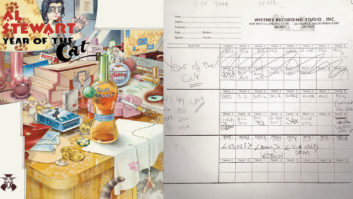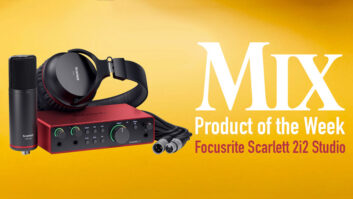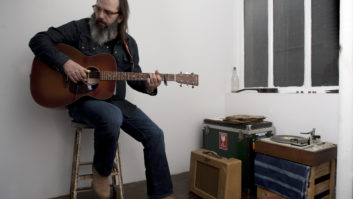
Studio Life – The Other Side of the Tracks was published in 1984, the first from Mix Books, after being serialized monthly in Mix magazine. Illustrated by Trici Venola and edited by Mix co-founder David Schwartz, the rollicking satire chronicles the colorful history of fictional Ryan Recording as told by studio manager Mr. Bonzai.
Join the crew at Ryan Recording—Mr. Bonzai, chief engineer Cart, receptionist and apprentice engineer Layla, and chief tech Smilin’ Deaf Eddie—as they struggle for respectability and profits in the music industry.It’s a satiric and whimsical journey through the hidden world of recording in the 1970s, filled with colorful characters and bizarre sessions.
“Mr. Bonzai has carefully split the difference between riotous comedy and real information and the result is a book that can be read with pleasure by anyone, whether they be studio moles or real human beings.You’ll learn a lot and you’ll laugh even more.”—Phil Austin, Firesign Theater
CHAPTER ONE: Just Managing
Managing a recording studio means stuffing your psychology degree into your shoulder holster, rolling up your sleeves and striking a friendly John L. Sullivan pose. Being prepared for the worst, you might be able to survive the bouncing check, the deals on “spec,” and accounts deceivable. I don’t mean to paint an unsavory image of the studio business, but it is a world filled with strange sidelights and unpredictable characters.
As I begin this memoir here in the front office at Ryan Recording, I am wedged between Johnny Terrific’s spare drums and Tumi Zorgath’s Monster-Module synthesizer. Things are a little tense due to a few minutes of dreaded “downtime.” This is like an unscheduled pit stop for a Formula One racer: endless moments of impotence while waiting for your stalled vehicle to get back on the track.
Fortunately, our maintenance man lives on the premises. This assures us of 24-hour security as well as prompt administration of solder, or whatever it takes at whatever hour to fix whatever went wrong. Eddie had once been a famous recording engineer and had become quite popular with record executives for his enthusiastic motto, “It’s a take!” Sadly, though, his reputation for speedy recording sessions became suspect when it was discovered that his hearing was slowly deteriorating as a result of an early Led Zeppelin session. Soon known as “Smilin’ Deaf’ Eddie, his career declined into obscurity.
Despite his damaged reputation, we recognized his unique electronic abilities and offered him a job in our maintenance department. Eddie is content these days to modify and service our equipment (a never-ending battle against electronic gremlins) and live in relative comfort in our workshop. The sight of Smilin’ Deaf Eddie strolling to the rescue in his bathrobe and slippers never fails to bring a smile of relief to every face. He’s an eccentric angel of goodness who watches over our studio.
Cart Ryan is the owner and chief engineer of Ryan Recording. Though only 22, he is already justly famous for his bold recording style. His drum sound has been likened to “a fleet of limousines backfiring in the Grand Canyon”; if you listen carefully you can hear his famous “phantom snare” haunting many of your favorite records. And, as studiophiles know, the Ryan piano sound has melted the hearts of rock stars and classical musicians alike.
Rounding out our staff is Layla, an aspiring engineer who assists on sessions and serves as our receptionist. A key player on the Ryan team, with all the delightful attributes of a rock’n’roll fantasy, Layla is always surprising us with her natural technical instinct. Too, there’s something especially comforting about having a woman reposition your microphone; a woman cuts the harsh electronic edge that can upset the mellow ambiance so vital to the making of successful recordings.
The session in progress, now stalled in downtime, is a simple radio commercial for Burger Boss. There are four account executives, a copywriter, a producer and three bigwigs in the studio, all being driven crazy by the nonstop smoking, gum chewing and name-dropping of the announcer, Hollywood deejay Jerry Jaws. Not far away, Stan “The Man” Stanley of the Lockwood, Hines, and Stanley ad agency, is arguing with one of the Burger Boss representatives over the proper delivery of the hook line, “We put our best meat between the finest buns.”
The experienced studio manager knows that sensible booking policies are important in maintaining a smooth operation. Leave adequate time between sessions to clear out the debris of one client and set up for the next. Not only will you save yourself the embarrassment of overlapping sessions, but you give the engineering department time to perform a little preventive medicine.
Still, Murphy has his ways. Our next client arrives an hour early, compounding the chaos. Rocky Ed Crockett, a cosmic dude to say the least, has been around for years, but remains relatively unknown to the general public. His biggest claim to notoriety is that he produced Howard Van Winkle’s novelty hit, “A Sheep at the Wheel.” Rocky is branching out as a solo dance-rock artist these days and is being handled by Clyde Eastman. Clyde is clad in a green pin-striped jumpsuit and arrives with Rocky’s wife Christina (heiress to the fabulous Zeller-Brown toilet paper fortune) in tow. Add four roadies and a handful of groupies to this high-powered recording team and we have an emotional jam session fueling the nervous tension of our embarrassing downtime.
Rocky appears to be taking the delay calmly, but when he cocks his coonskin cap on the back of his head and mutters snidely about “professional studios,” I start feeling the uptight vibes in abundance from ad people and rockers alike. I try to ease the tension with shaggy-dog stories of horrible sessions I have known. No dice. I suggest a little recreation and point to our game room, complete with pinball, air hockey, ping-pong, and hula-hoops. No takers. Layla parades around with a tray of herb tea, coffee and Perrier. Nothing seems to work.
The agency has to have the commercial finished and on the air within hours. Rocky Ed is snortin’ like a bull to record “Disco Doody,” his danceable version of the old Howdy Doody theme song. After formally introducing everybody to each other, I excuse myself to find out what’s happening in the control room. There I find Cart playing hunt-and-peck with the more than four thousand buttons on our new automated Super Sonic II mixing console.
“What seems to be the problem?” I ask.
Cart shrugs and looks up at the ceiling. “Listen to this.” He plays the commercial and I can barely recognize Jerry Jaws’ fevered pitch for “1000% lean, textured beef.”
“It sounds like a parrot with emphysema,” I tell him.
“Let’s get Eddie in here and get this session rolling pronto!”
I tear out of the control room, intercept Layla and send her off to awaken Eddie. Luckily, Rocky and Jerry have discovered that they are old friends from Berkeley and are entertaining the impatient clients just like they did at the People’s Pep Rallies. Moments later, Eddie stumbles through the lobby in his bathrobe, waving and smiling. The raucous levels drop to zero dB. I quickly usher Eddie into the control room and close the airlock so I can yell loud enough to make him understand the gravity of the situation. He looks calmly at the console, asks Cart a few questions and informs me that it will take about three hours to check out all the power supplies—“or I can try to fix it temporarily.”
I nod vigorously, eyes bugging out. “Yes—get it working now!”
I watch carefully, hoping to learn some tricks for future emergencies. Eddie stands over the board like a Kung Fu master for a few seconds, then brings the heel of his hand down sharply on the Allen screw that holds the 23rd module in place. The plasma meters snap into action, and Eddie shrugs and smiles.
As usual, I am amazed by Eddie’s unorthodox yet effective methods. Sure, I fix my TV at home with a good whack or a shoe thrown from across the room but who would expect such measures in a professional recording studio? No time to ponder, though. It’s time to sell some burgers and studio time. In ten minutes we have hustled the advertising team back into the control room, re-cut the voiceover, mixed the commercial and sent them on their way.
Rocky’s roadies now bring in the many cases that house his instruments and highly specialized equipment. As they begin unpacking the zithers and blowing up Rocky’s recording couch (he won’t let them use pumps—it’s not as inspiring), I realize that Eddie will have plenty of time to repair the console while they “get in the groove.”
Out of one road case comes the most beautiful Persian hookah I have ever seen. Handcarved with scenes from the Kama Sutra, it glistens with gold and ivory as the roadie plugs in the aquarium pump that will keep lovely clouds of primo smoke billowing forth throughout the session. Rocky boasts that his government-approved Afghani Gold Stamp hash is smuggled to order in bongo drums.
It’s almost religious, the way he gets into a recording session.
Next comes the pure cocaine, which Rocky says he gets from a sociology professor who works with the Indians in Peru. One speck of this magic dust and you could cross the Isthmus of Panama on your hands and knees.
The roadie, Jake, hefts a flour sack full of the stuff onto the mixing console as I run to lock the door and turn on the heat-sensitive burglar alarm. (Every good recording studio has a foolproof surveillance system—closed circuit TV, infrared sensors, hidden microphones, pressure plates under the welcome mat—just in case. )
Christina places a mirror from an antique medicine cabinet on the producer’s desk, pulls a small meat cleaver out of her holster, and begins to chop the rocky powder and arrange it in neat little lines (actually rails about eleven inches long). She coos lovingly to Rocky and hands him a Dixie cup with the bottom cut out. He puts it to his nostril, bends over the mirror and inhales deeply; thousands of dollars worth of cocaine disappear like magic.
His eyes widen; he assumes a majestic pose and says, “All right!! Let’s boogie!” like I’ve never heard it said before.

Learn more and check out samples for the iPad and Kindle at: http://www.mrbonzai.com







